
Earlier this year, Jesse Dufton became the first blind climber to lead a climb on Devil's Tower, Wyoming, USA.
The route in question - El Matador (5.10d) - comes in at 5.10d, a grade roughly equivalent to E3, and has been described by Jesse as the hardest route he has ever attempted.
After an unfortunate end to a promising on-sight attempt - or 'non-sight', in Jesse's own words - Jesse's eventual success on the route not only marked new ground for him as an individual, but served as inspiration for countless others.
We got in touch with Jesse to ask him more about the route, his memories of it, and what he's been up to since:
How did the idea of climbing the Devil's Tower first come about? And what was it that inspired you to go for it?
A few years back I attended a talk from rock queen Catherine Destivelle. She mentioned a few routes that resonated with me. The Old Man of Hoy being one, but another was El Matador on Devil's Tower. I'd not heard of Devil's Tower before, but it sounded like an incredible piece of rock.
After the talk I researched the route and found a couple of things that attracted me. The columnar rock is quite like Kilt Rock and Fairhead, both locations where I've done well, and the rock has suited my style.
The crux pitch follows a square-cut slot between two columns, so there is no danger of me getting lost and heading off route. Also, endurance is a critical factor, and my endurance is a stronger aspect of my climbing. Lastly, the grade is 5.10d, which rightly or wrongly, I mentally converted to E3.
For a while I have been wanting to on-sight an undisputed E3. I have already on-sighted some routes on the E2/E3 border, such as Forked Lightning Crack (E2 5c), Internationale (E2 5c) and Destiny (E2 5c), but for me I don't feel like I've really achieved the grade until I've on-sighted one that is beyond question. I had thought El Matador could be the one.
Molly got hold of an old guidebook for the tower and read a few extracts out to me - the history was really quite interesting from the first ascensionists to the parachuter stuck on top. I was hooked, and although I wouldn't be able to fully appreciate the stunning visuals, I was determined to one day 'feel the power of the tower!' as the locals say.
Talk us through the route, how does the climbing break down? And what were the most challenging aspects of the climbing?
El Matador is six pitches. Pitches one and three are 5.8 (VS), beautiful steady crack climbing. Pitches five and six are also around 5.8 but the rock becomes noticeably more weathered, needing more care.
The difficulties on El Matador are compressed into pitch two and pitch four. Pitch four passes a set of double overhangs, it gets 5.10a, nominally E1, but the crux of the route and the defining feature come in the second pitch. It's like a three-sided elevator shaft that rises straight up between two of the tower's columns.
Apparently, it is thirty-eight metres tall, but the number doesn't do it justice. When you're in it, it feels like it goes on forever. When Molly described it to me from the ground, she thought the sidewalls were totally parallel, but when you get up close and personal, you realise that the left sidewall overhangs slightly and the right sidewall is not perpendicular to the backwall. Rather, it's canted out slightly at 100 or 110 degrees, meaning, when you smear on it, it often feels like if you lose pressure or concentration your right foot might slip outwards precipitating your dismount from the route.
In short, it's all about the second pitch. Our ancient second-hand guidebook suggested laybacking the crack in the left corner of the shaft to begin with before swapping to bridging between the sidewalls higher up where the shaft narrows. I am reasonably tall, and to my surprise when I reached the base of the shaft, I was able to reach out and touch both sidewalls with my hands simultaneously, it must be about 1.7m wide.
So, I bridged from the very beginning. There is a series of finger-locks in the left crack to about halfway up the pitch, and the left then seals up. I used the right to about three-quarters height, where both left and right are sealed and I transitioned to an iron cross style double palm-down to move my feet up. Like something from the final of ninja warrior, I had to press outwards with everything I had to do this - my friend reckons the columns are slightly wider apart now!
Individually, none of the moves are stoppers, but the cumulative fatigue is outrageous. For me, the killer was the footholds. I only found two footholds on the thirty-eight metre pitch; I was constantly smearing between the sidewalls, strenuous with a burning in my calves like never before. Molly couldn't spot any feet for me from her belay stance, but crushingly, when she climbed the pitch, she informed me that there are in fact loads of tiny edges and dishes to use for your feet. Clearly, skipping all of these made it significantly harder and more brutal for me than if I were able to see where to put my feet.
What's your process when going for an ambitious lead like this? How do you and Molly go about preparing and planning for the route?
The first thing is to analyse any route descriptions available - I don't want beta, but I do want to know if the route will be safe for me. Phrases like "small, marginal and infrequent gear" or "insecure and tenuous climbing demanding precise footwork" would be big turn offs. Routes which follow an obvious feature, as El Matador does, are often preferred.
When we arrive at the crag, Molly will have a good look at the route from the ground and from as many angles as she can. She wants to spot as many critical holds or gear placements as possible in advance, as when she is beneath me belaying these might be out of view.
She'll then describe these to me so I can be searching for them as I climb even if she can't see them from the belay. She has a pair of fancy Swarovski Optik binoculars that really help with this.
For example, she was able to spot the bolts of the second anchor from the floor with them. Knowing roughly where a bolted anchor is helps me hugely as I can have trouble finding them - they're much harder to find when you can't see than cracks to build a trad anchor are.
Once she's spotted all she can, we check that I've got all the rack we think I'll need, and it's sorted on my harness so I can find a particular bit quickly. She also lets me know if there will be any parts of the route that I potentially climb out of her sight. For El Matador, it wasn't totally clear but on pitch four, Molly thought I may be out of her sight once past the roof.
She tries to identify things like this and describe the shapes and features in more detail for these sections so that when we get there, we're prepared for the most difficult scenario and anything better is a bonus. Then it's just down to me and off I go, with Molly in the radio in my ear calling out whatever she can see as I climb. Fortunately, no narration about the local wildlife while I'm in the crux this time...
Talk us through the on-sight attempt, where did it go wrong?
There was some excitement just off the belay. When I was going well. I had made it just over half-way up the shaft and found a foothold, which I milked. It was a battle, and I was tired especially in my calves, but I was doing well, and I set off again.
A little higher and I was back in the bridge with my feet. I moved my right foot up, I readjusted, and unexpectedly my right foot slipped out of the right-hand crack, and I was in the air and taking the ride.
I hung on the rope heartbroken and gasping. I didn't know what happened at the time, we later realised that there is a small shrub growing out of the crack. Because I can't see, I was unaware and had inadvertently stood on it with my right foot and it had caused me to slip. To my exasperation, when Molly climbed the pitch, she related that it is the only vegetation anywhere on it, and it likely only persists as it is next to a ledge most climbers likely stand on and so the shrub survives.
Clearly, I had the double whammy of missing a foothold and standing on the slippery plant as I couldn't see either. Non-sight onsighting is a cruel game, as there is zero room for error.
What are your standout memories from your time on the route?
In general, of exertion, dehydration and calf pain. But two incidents also stand out. The first was right at the start of the crux pitch. I'd climbed three metres off the belay ledge, placed a bomber size 11 nut to settle the nerves and rule out a factor two. But one of the many problems about not being able to see is that you are liable to accidentally kick your gear, which, as I moved up, is exactly what I did. The nut stayed in place, but somehow, I had kicked the gate of the quickdraw open, and it detached from the wire and sailed down the rope to Molly. Five metres up and back to looking at a factor two was not the nice relaxing intro I was after.
The second incident was just over three quarters of the way up the pitch. I had passed the hardest double bridging section, which was, as I remember, reasonably run out, and placed a wire. I was exhausted and could feel my left foot slipping. I quickly fumbled round the back of my right hip in search of a quickdraw. I felt the folded strands of dyneema on what I assumed was an extendable quickdraw. I grabbed the crab and clipped it to the hanging wire.
Only then, to my horror, did I realise that it was in fact a cam and I wouldn't be able to clip my rope. With the run out below me and mild panic setting in, I groped around for another crab, and snapped it to the wire, only to find that, in my anguish, this was also a cam. I was out of quickdraws on my right side. With my calves screaming and my pulse hammering, I managed to rectify the situation and eventually got one of the draws from my left in, clipped it and continued the upward battle. Oh, if only I could see what I was doing!
What about you Molly, what are your standout memories from the day?
It'll be hard to forget the moment Jesse put his head in his hands having just fallen off after the fight of his life up the crux pitch. He'd been gutted about falling off routes before, but nothing like this. He was distraught, everything seemed to just drain out of him. I felt pretty helpless at the belay below. I don't think any words would have made it better. I just wanted to give him a hug, but being the stubborn and determined person he is, down was not an option.
The other standout memory was on the fourth pitch. I could see a little notch on the arete which I thought would be critical for turning the first roof. Beyond this, he was going to be on his own, out of my sight. When he climbed up to this point, he felt out with his hand to feel this 'notch', only a slight change in angle on the rock. "There's nothing there". My heart sank a little, but I couldn't see anything else. Without a second thought, he thought: let's go, foot on the notch, rock over. Let's go.
His trust and intuition are out of this world. Off he went, rocked over, reached out to where he needed a hold, found something good enough and pulled round. It was incredible. To witness this sheer bravery and confidence to go into the unknown blows my mind still. There is no better feeling than watching Jesse pull something like this off – it was magical.
Jesse, how does this route compare to your other hard ascents?
It is the hardest trad route I have ever attempted, and by a margin. Nominally it is graded 5.10d that I mentally converted to E3. But, from talking to local guides after my attempt, what I had not realised is that it is a massive sandbag and more like mid 5.11, that would make it solid E4, although clearly I'm in no position to judge! It was just far more than I had bargained for.
Additionally, it is very different to anything I have ever climbed before. I can't think of any routes in the UK that have the repetitive bridging that defines the route. It was a style I'd never encountered. I'm sure with practice it would feel considerably easier, but finding some footholds would also help.
What is not in question is the quality of the first four pitches, they are immaculate – it is incredible climbing and a route that is now seared into my memory.
You've made some impressive ascents in the weeks since your return to the UK. How has your experience climbing in the US affected your climbing back home?
I think the clearest effect was when I got on The Bludgeon (E1 5b) at Shepherd’s Crag. I made short work of getting onto the pinnacle. From Molly's inspection of logbooks afterwards, some say mounting the pinnacle is the crux, but, for me, I struggled with the final steep wall.
Clearly, I was missing some holds. Molly couldn't see anything as she was belaying from below, so I climbed up and down, searching the wall as best I could before returning to the awkward rest on the pinnacle. It took me hours – I was so sorry to have put Molly through one of her longest "endurance belays". But the critical thing was that with the disappointment of blowing the on-sight of El Matador fresh in my mind, there was no way I was caving in on The Bludgeon and backing off or dogging this one. I had the bit firmly between my teeth and there was no way I was letting go.
Routes like The Bludgeon are extra hard for me because there are jugs to go for, and for most people they can see the jug and simply blast through the hard move before grabbing it. But, for me, I must be in total control throughout, locked off searching move by move, not knowing what is coming next. I eventually worked out that I had initially been missing a critical foothold and ticked off the non-sight.
It was similar for The Sting (E2 5c) at Steel Knotts (Borrowdale). I got up to the harder section, realised I'd got the sequence wrong, but I didn't panic. I stepped down, managed to reset and got it clear in my mind what I needed to do. I then executed the moves and before I knew it, I was stood up on the ledge having got through the crux.
My most recent outing was at Cratcliffe. Molly was confident I would be able to do Five Finger Exercise (E2 5c). I came round to the idea and was up for giving it a go. There was a little traverse right in the middle with tiny holds and no gear which felt really off-balance.
It took me a while to work out the moves and commit to going, and similarly on the top flake, it took me ages to commit to the moves. I was having a bad head day, when nothing was really clicking, I think the frustration from the lost on-sight on El Matador was still burning and gave me the motivation I needed. Once I felt I had a good enough hold on the flake, I just went and wasn't stopping, not even to place any gear. A quick smooth ascent it was not, but I got the non-sight and was so chuffed.
What's else have you been up to, and what's next for you?
I am still hoping for a solid E3 on-sight in the UK over the summer, but we've also recently been out to the Dolomites. The next big trip will be back to the USA in early October, splitting the trip between Red Rocks and Zion.
Currently I'm not sure what to try - I think Return of the Sleepwalker (f9A) might be a bit too ambitious, but I've heard that Red Rocks isn't short of quality lines, so we will have to see.
One thing that does concern me is the length of some of the routes. Given that I was on a twenty-two metre route for about three hours when I did The Bludgeon, I think I might need to pick up the pace somewhat before October or I'll still be there in 2025!

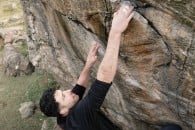















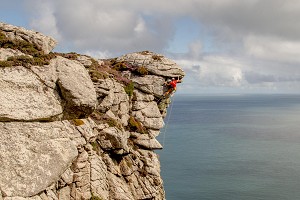
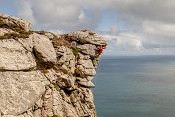
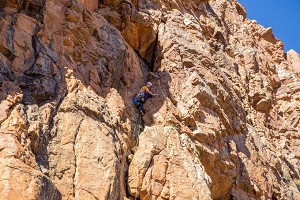
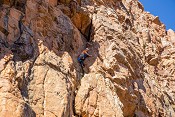


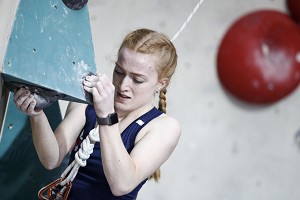
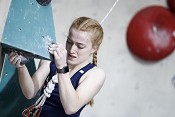
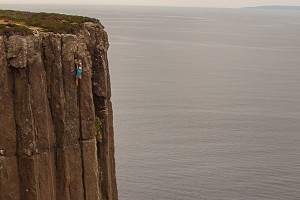


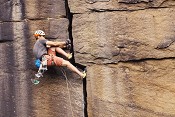
Comments
This stuff is absolutely mind blowing. I absolutely cannot comprehend how you would do the traverse on five finger exercise blind, let alone the harder stuff Jesse has recently done!
I still find it disappointing that this piece of sacred rock was not renamed.
The guy is a star; somehow I find what he does much more interesting and inspiring than cutting edge climbing by sighted elite climbers.
What an inspiring story,he is an absolute hero
Full respect to Jesse ... and what a fabulous ascent .. Brilliant news.
However, I am amazed and staggered (don't understand) at how Jesse arranges pro (en route) and belay stations and has some cognisance of drops/height etc without sight ... no way I could do that... simply fabulous
Hats off to you Jesse ... Well done and any climbing tips please